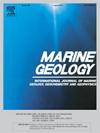Evaluating longshore sediment transport: A comparison between empirical formulas and XBeach 2DH numerical model
IF 2.6
3区 地球科学
Q2 GEOSCIENCES, MULTIDISCIPLINARY
引用次数: 0
Abstract
Longshore sediment transport (LST) is a crucial process shaping coastal environments. As multiple site-specific factors (e.g. wave height, coastal topography) influence the LST, an accurate estimation of LST rate represents a scientific challenge.
This research evaluates the predictive capacity of three widely used empirical formulas (CERC, 1984; Kamphuis, 1991; Van Rijn, 2014) and the XBeach 2DH numerical model for estimating the LST rate by comparing the obtained results with field LST data.
We chose three coastal sites in Malta Island (Għadira Bay, GB) and northern Sicily (Cefalù, CF, and Campofelice di Roccella, CR) based on different sediment grain size, coastal type (open or embayed) and morpho-bathymetry.
For each site, we analysed wave parameters, grain size of the beach and seabed sediments, coastal morphology, and marine vegetation distribution. Furthermore, we used field measurements to calibrate the numerical model's sediment transport and morphological parameters.
The calibrated numerical model provides greater accuracy in LST rate estimation than the empirical formulas. The latter overestimates the LST rates by factors ranging from 435 to 7885, whereas the numerical model overestimates by factors of 1.8 and 1.9 at the CF site and GB, respectively, and underestimates by a factor of 0.5 at the CR site.
The good performance of the numerical model is due to its consideration of site-specific factors. The parameter values for the model calibration can be used successfully in embayed fine/coarse sandy beaches. Moreover, the numerical model, tested so far only for sandy beaches, also works well on gravelly beaches.
海岸带泥沙输移的经验公式与XBeach 2DH数值模型的比较
海岸带输沙是海岸带环境形成的重要过程。由于多个特定地点的因素(如浪高、海岸地形)会影响地表温度,因此准确估计地表温度率是一项科学挑战。本研究评估了三个广泛使用的经验公式的预测能力(CERC, 1984;Kamphuis, 1991;Van Rijn, 2014)和XBeach 2DH数值模型,通过将获得的结果与现场LST数据进行比较来估计LST率。我们选择了马耳他岛(Għadira Bay, GB)和西西里岛北部(Cefalù, CF和Campofelice di Roccella, CR)三个沿海站点,基于不同的沉积物粒度、海岸类型(开放或海湾)和形态测深。对于每个地点,我们分析了波浪参数、海滩和海底沉积物的粒度、海岸形态和海洋植被分布。此外,我们还利用野外测量校准了数值模型的输沙量和形态参数。与经验公式相比,校正后的数值模型对地表温度的估计精度更高。后者高估了435 ~ 7885个因子,而数值模式在CF和GB分别高估了1.8和1.9个因子,在CR低估了0.5个因子。数值模型的良好性能是由于它考虑了具体的场地因素。模型标定的参数值可以成功地应用于海湾细/粗沙滩。此外,到目前为止仅对沙质海滩进行了测试的数值模型也适用于砾石海滩。
本文章由计算机程序翻译,如有差异,请以英文原文为准。
求助全文
约1分钟内获得全文
求助全文
来源期刊

Marine Geology
地学-地球科学综合
CiteScore
6.10
自引率
6.90%
发文量
175
审稿时长
21.9 weeks
期刊介绍:
Marine Geology is the premier international journal on marine geological processes in the broadest sense. We seek papers that are comprehensive, interdisciplinary and synthetic that will be lasting contributions to the field. Although most papers are based on regional studies, they must demonstrate new findings of international significance. We accept papers on subjects as diverse as seafloor hydrothermal systems, beach dynamics, early diagenesis, microbiological studies in sediments, palaeoclimate studies and geophysical studies of the seabed. We encourage papers that address emerging new fields, for example the influence of anthropogenic processes on coastal/marine geology and coastal/marine geoarchaeology. We insist that the papers are concerned with the marine realm and that they deal with geology: with rocks, sediments, and physical and chemical processes affecting them. Papers should address scientific hypotheses: highly descriptive data compilations or papers that deal only with marine management and risk assessment should be submitted to other journals. Papers on laboratory or modelling studies must demonstrate direct relevance to marine processes or deposits. The primary criteria for acceptance of papers is that the science is of high quality, novel, significant, and of broad international interest.
 求助内容:
求助内容: 应助结果提醒方式:
应助结果提醒方式:


